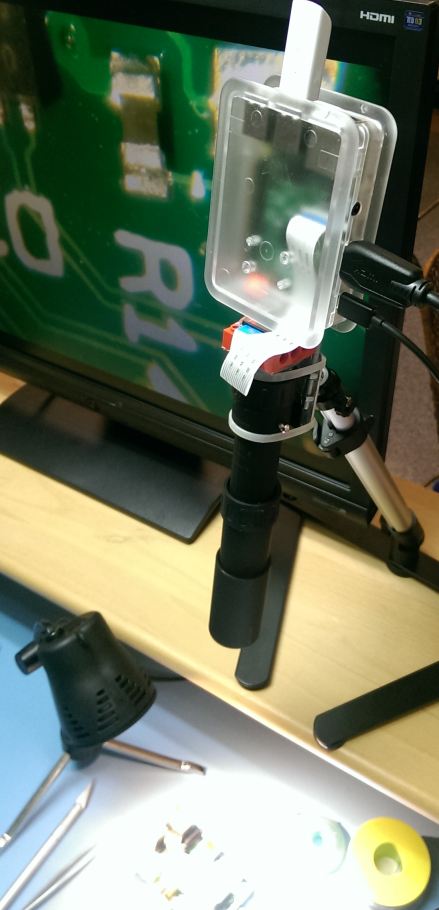Once you have used a microscope for soldering 0402 and QFN SMD parts you don’t want to go back to solder-joint-guessing. Ideally it is a stereo microscope with a decent view window – like the Mantis Elite, an absolutely awesome device. Just a bit out of my basement lab budget. Then Dave on the EEVblog #585 showed off his Tagarno Magnus HD Digital Microscope. “Beauty!” yet again a bit pricey for my occasional use.
I wanted adjustable zoom so I can see the solder fillet on QFN’s when needed while not getting locked down into details during assembly. I asked my friend Benny, a passionate hobby photographer for some ideas … and that’s what he came up with:
A high zoom factor camera and some lenses from an analog SLR camera. Concept proof! Now we just need no-lag-HQ livestream to a big screen.. A version with a USB webcam worked, but required a computer and zoom was not enough. A quick test with a €50 Hilkinson 8-25x Zoom Monocular looked promising, so a Raspberry Pi camera module was ordered.
Putting it together was no easy task, since the lens alignment is crucial. A slider setup with Lego worked well and allowed me to adjust the camera one-sheet-of-a-paper at a time:
Some Ethylene vinyl acetate copolymer, high performance precision spacers and pressure cast mounting brackets where used to secure it in place. Hot glue, Lego bars and zip ties just sounded too cheap.
A Raspberry Pi B+ takes the serial camera signal to a live ethernet stream, records it or directly outputs it to HDMI:
raspivid -t 0 -rot 0 -fps 25
The final setup with 27+ cm working distance. 8-25x zoom with manual focus.
And this is what the output (raspistill) looks like. The red rectangle overlay shows the 1920 x 1080 default video output. Zoom is somewhere in the center of the 8-25x range. Picture is still a bit blurry as I have not yet adjusted the camera lens properly.




Except for the choice of microprocessor, it seems a great and worthwhile project.
It can also be an aid for older, sight-challenged people.
Absolutely Brilliant!
And I reply to my own comment – Be sure to post about this over in the RaspberryPi.org forums.